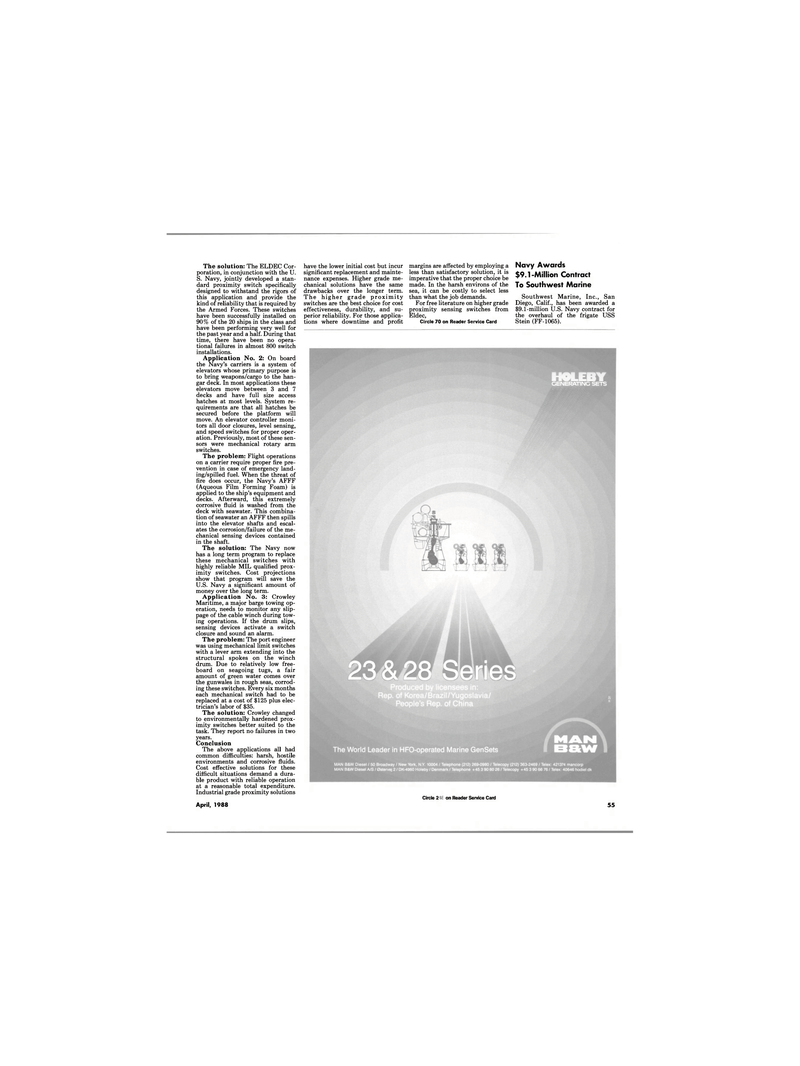
Page 55: of Maritime Reporter Magazine (April 1988)
Read this page in Pdf, Flash or Html5 edition of April 1988 Maritime Reporter Magazine
The solution: The ELDEC Cor- poration, in conjunction with the U.
S. Navy, jointly developed a stan- dard proximity switch specifically designed to withstand the rigors of this application and provide the kind of reliability that is required by the Armed Forces. These switches have been successfully installed on 90 % of the 20 ships in the class and have been performing very well for the past year and a half. During that time, there have been no opera- tional failures in almost 800 switch installations.
Application No. 2: On board the Navy's carriers is a system of elevators whose primary purpose is to bring weapons/cargo to the han- gar deck. In most applications these elevators move between 3 and 7 decks and have full size access hatches at most levels. System re- quirements are that all hatches be secured before the platform will move. An elevator controller moni- tors all door closures, level sensing, and speed switches for proper oper- ation. Previously, most of these sen- sors were mechanical rotary arm switches.
The problem: Flight operations on a carrier require proper fire pre- vention in case of emergency land- ing/spilled fuel. When the threat of fire does occur, the Navy's AFFF (Aqueous Film Forming Foam) is applied to the ship's equipment and decks. Afterward, this extremely corrosive fluid is washed from the deck with seawater. This combina- tion of seawater an AFFF then spills into the elevator shafts and escal- ates the corrosion/failure of the me- chanical sensing devices contained in the shaft.
The solution: The Navy now has a long term program to replace these mechanical switches with highly reliable MIL qualified prox- imity switches. Cost projections show that program will save the
U.S. Navy a significant amount of money over the long term.
Application No. 3: Crowley
Maritime, a major barge towing op- eration, needs to monitor any slip- page of the cable winch during tow- ing operations. If the drum slips, sensing devices activate a switch closure and sound an alarm.
The problem: The port engineer was using mechanical limit switches with a lever arm extending into the structural spokes on the winch drum. Due to relatively low free- board on seagoing tugs, a fair amount of green water comes over the gunwales in rough seas, corrod- ing these switches. Every six months each mechanical switch had to be replaced at a cost of $125 plus elec- trician's labor of $35.
The solution: Crowley changed to environmentally hardened prox- imity switches better suited to the task. They report no failures in two years.
Conclusion
The above applications all had common difficulties: harsh, hostile environments and corrosive fluids.
Cost effective solutions for these difficult situations demand a dura- ble product with reliable operation at a reasonable total expenditure.
Industrial grade proximity solutions have the lower initial cost but incur significant replacement and mainte- nance expenses. Higher grade me- chanical solutions have the same drawbacks over the longer term.
The higher grade proximity switches are the best choice for cost effectiveness, durability, and su- perior reliability. For those applica- tions where downtime and profit margins are affected by employing a less than satisfactory solution, it is imperative that the proper choice be made. In the harsh environs of the sea, it can be costly to select less than what the job demands.
For free literature on higher grade proximity sensing switches from
Eldec,
Circle 70 on Reader Service Card
Circle 223 on Reader Service Card
Navy Awards $9.1-Million Contract
To Southwest Marine
Southwest Marine, Inc., San
Diego, Calif., has been awarded a $9.1-million U.S. Navy contract for the overhaul of the frigate USS
Stein (FF-1065).
April, 1988 55

 54
54

 56
56
